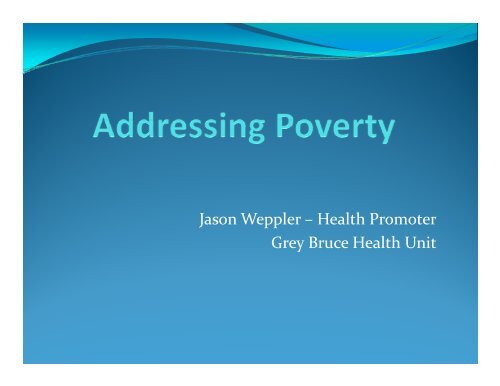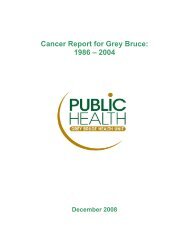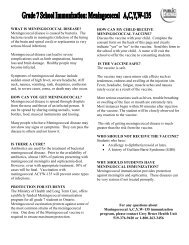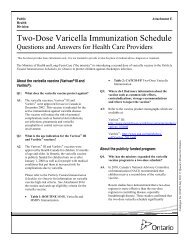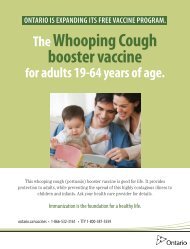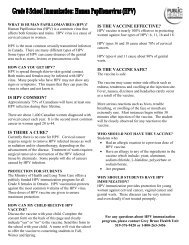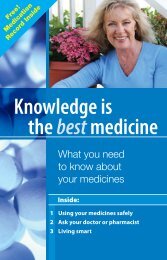Addressing Poverty In Grey Bruce - Grey Bruce Health Unit
Addressing Poverty In Grey Bruce - Grey Bruce Health Unit
Addressing Poverty In Grey Bruce - Grey Bruce Health Unit
Create successful ePaper yourself
Turn your PDF publications into a flip-book with our unique Google optimized e-Paper software.
Jason Weppler – <strong>Health</strong> Promoter<br />
<strong>Grey</strong> <strong>Bruce</strong> <strong>Health</strong> <strong>Unit</strong>
Ontario’s <strong>Poverty</strong> Reduction Strategy<br />
• 25 in 5 (reduce poverty by 25% in 5 years)<br />
• will move 90,000 children out of poverty<br />
• based on Statistics Canada’s Low <strong>In</strong>come Measure<br />
(50% of median income or $27,000 for single Mom<br />
with two kids in Toronto)
Strategy #1 Ontario Child Benefit<br />
• <strong>In</strong>crease of up to $1310 per child per year<br />
• Support for 1.3 M children in low‐income families
Strategy #2 Parenting and<br />
Family Literacy Centres<br />
• Ti Triple Number of Centres to 300<br />
• Located in Schools<br />
• Helps prepare children and families for transition to<br />
• Helps prepare children and families for transition to<br />
kindergarten
Strategy #3 After School Programs<br />
• $10 M annually<br />
• Support children in high needs neighbourhoods with<br />
new programming<br />
• Currently 237 program operating
Strategies #4 Youth Opportunities Strategy<br />
• Help Kids Overcome Economic Disadvantages<br />
• Jobs, Training and Outreach<br />
• Eg. Summer Job Program, YouthConnect.ca, Youth<br />
Outreach Worker Program
Strategy #5 Provincial Rent Bank Program<br />
• Has Prevented More Than 15,500500 Evictions<br />
• Dedicated Commitment of 5 M/year<br />
• 2009 $60B infrastructure plan for social housing
Strategy #6 Community Opportunities Fund<br />
• Funding to Encourage Neighbourhood Revitalization<br />
• Assist Local Leaders in Coordinating Revitalization<br />
Projects
Strategy #7 Community Hub Program<br />
• Focus on Schools as Hubs of the Community<br />
• Provide Educational and Social Supports
Strategy #8 Student Nutrition Program<br />
• <strong>Health</strong>y breakfasts, snacks and lunches<br />
• Create 700 New and Expand 300 Existing Programs
INDICATORS:<br />
1. School Readiness (EDI)<br />
2. Depth of <strong>Poverty</strong><br />
3. Low <strong>In</strong>come Measure<br />
4. Standard of Living (Deprivation <strong>In</strong>dex)<br />
5. Ontario Housing Measure<br />
6. Birth Weights<br />
7. High School Graduation Rates<br />
8. Educational Progress (EQAO)
Reducing <strong>Poverty</strong> in Ontario –<br />
A Place Based approach<br />
• June 10, 2009<br />
• Kitchener, Ontario<br />
• Guest Speakers:<br />
• Sherri Torjman – Caledon <strong>In</strong>stitute of Social Policy<br />
• Db Deb Matthews – Minister i of Children & Youth Serv.<br />
• Robin Cardozo – CEO Ontario Trillium Foundation
Ontario’s Goal is 25 in 5…<br />
•What Number is your<br />
Community Going to Achieve
PLACE BASED PREMISES TO<br />
POVERTY REDUCTION<br />
• <strong>In</strong>terventions and Actions Carried out in Place – in<br />
Neighbourhoods, Towns and Cities<br />
• <strong>Poverty</strong> is a Complex Problem Best Tackled Through h a<br />
Variety of <strong>In</strong>terventions<br />
• Place Based Approach to <strong>Poverty</strong> Addresses Chapter 2<br />
of Ontario’s <strong>Poverty</strong> Reduction Strategy
WHY PLACE BASED<br />
• Communities are Unique – Strengths and Needs<br />
• One Strategy Doesn’t Work For All<br />
• Those in <strong>Poverty</strong> Live Somewhere<br />
• Past Places May Affect Current Place
PLACE BASED INTERVENTIONS<br />
• Population <strong>Health</strong><br />
• Social <strong>In</strong>frastructure<br />
• Social Capital<br />
• Social <strong>In</strong>clusion<br />
• Early Childhood Development<br />
• Human Capital<br />
<strong>Poverty</strong> is not all about income but places where people<br />
can go, gather, etc. that affects their quality of life
BUILDING RESILIENCE<br />
• Four Major Areas Of <strong>In</strong>vestment<br />
1. Sustenance (food security, housing, income security)<br />
2. Adaptation (Literacy, Networks, E. C. Development)<br />
3. Opportunity (employability, job creation, asset<br />
building, ownership)<br />
4. Engagement (cultural expression, empowerment,<br />
meaningful participation)<br />
Can’t address all areas at once but no one piece stands alone
Bridges Out Of <strong>Poverty</strong><br />
• June 18, 2009 Hosted by <strong>Grey</strong> <strong>Bruce</strong> Children’s Alliance<br />
• Owen Sound, Ontario<br />
• Gayle Montgomery/Mary Lou Robb –<br />
Lambton County Social Services<br />
• Help professionals gain a deeper understanding of the<br />
challenges and strengths of people living in poverty
BRIDGES OUT OF POVERTY<br />
• <strong>Poverty</strong> – “the extent to which an individual does<br />
without resources” (financial, emotional, physical etc.)<br />
• 87% of “work time “ spent dealing with service<br />
providers<br />
• Low <strong>In</strong>come Measure Family of 3 = $22,239<br />
Ontario Works provides $13,740
“Mental Models” of <strong>Poverty</strong><br />
• Mental Models are an internal picture of how the world<br />
works; determines how we act<br />
• <strong>Poverty</strong> – “Relationships”<br />
Focus on food, housing, jobs, transportation<br />
• Middle Class – “Achievement”<br />
Focus on education, careers, retirement, and vacations<br />
• Wealth – “Connections”<br />
Focus on politics, private clubs, finances and travel
Mental Model ‐ Businesses<br />
• <strong>Poverty</strong> – Predatory Businesses<br />
Pawn shops, liquor stores, fast food, check cashing,<br />
laundromat, “rent to own”, used car lots<br />
• Middle Class – Shopping Malls, bookstores, banks,<br />
fitness centers, coffee shops, golf courses, restaurants<br />
• Wealth – Corporations, <strong>In</strong>ternational Business, Event<br />
Sponsorship, Boards of Directors
“Hidden Rules” of Economic Class<br />
• <strong>In</strong>dividuals Bring Hidden Rules of Class in Which They<br />
Were Raised<br />
• Schools and Businesses Operate From Middle Class<br />
Norms (proactive, abstract and verbal)<br />
• Need to Understand and Use the Hidden Rules to<br />
Need to Understand and Use the Hidden Rules to<br />
Improve Relationships and Program Design.
Examples of “Hidden Rules”<br />
TIME:<br />
<strong>Poverty</strong> –present most important and decisions are<br />
made for the moment on feelings or survival<br />
Middle Class – Future is most important and decisions<br />
i<br />
are made against future ramifications<br />
Wealth –Traditions and history are most important and<br />
decisions are made partially on this basis
Example #2<br />
• POWER:<br />
• <strong>Poverty</strong> –power linked to personal respect; can’t stop<br />
bad things from happening<br />
• Middle Class –power and respect are separated; power<br />
in information and institutions<br />
• Wealth –power in expertise, connections and stability.<br />
Power influences policy and direction.
Bridges Out of <strong>Poverty</strong><br />
• “Many successful people are inclined to attribute their<br />
situations to their own ability and effort – making<br />
them, in their minds, more deserving than less<br />
successful people. They ignore the support they<br />
received from families, networks of friends and kin,<br />
schools and powerful others.”<br />
• “No significant learning occurs without a significant<br />
relationship.”<br />
Dr. James P. Comer


